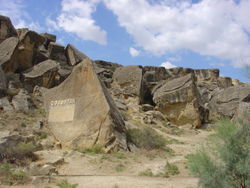Gobustan State Historical and Cultural Reserve
| UNESCO World Heritage Site | |
|---|---|
 | |
| Criteria | Cultural: iii |
| Reference | 1076 |
| Inscription | 2007 (31st Session) |
Gobustan State Reserve located west of the settlement of Gobustan, about 40 miles southwest of the centre of Baku was established in 1966 when the region was declared as a national historical landmark of Azerbaijan in an attempt to preserve the ancient carvings, mud volcanoes and gas-stones in the region.
Gobustan State Reserve is very rich in archeological monuments, the reserve has more than 600,000 rock paintings, which depict primitive men, animals, battle-pieces, ritual dances, bullfights, boats with armed oarsmen, warriors with lances in their hands, camel caravans, pictures of sun and stars, on the average dating back to 5,000-20,000 years. [1]
Today Gobustan is the most popular state reserve and is an invaluable treasure-house of Azerbaijan. For other state reserves see State Reserves of Azerbaijan.
Prehistoric carvings
The rock carvings and petroglyphs at the site display mesmerizing images of prehistoric life in the Caucasus. The well-preserved sketches display ancient populations travelling on reed boats; men hunting antelope and wild bulls, and women dancing.[2] The famed Norwegian anthropologist Thor Heyerdahl returned many times to Azerbaijan between 1961 and his death in 2002 to study the site in his "Search for Odin".
Mud volcanoes
It's estimated that 300 of the planet's estimated 700 mud volcanoes sit Gobustan, Azerbaijan and the Caspian Sea.[3] Many geologists as well as locals and international mud tourists trek to such places as the Firuz Crater, Gobustan, Salyan and end up happily covered in mud which is thought to have medicinal qualities.[4] In 2001 one mud volcano 15 kilometers from Baku made world headlines when it suddenly started spewing flames 15 meters high. [5]
Gaval Dash
The Gaval Dash is a natural musical stone which can only be found in Gobustan, Azerbaijan. Among the stone books there are a big flat stone formed out of 3 supports. Suffice it to touch the object with a small stone, musical sounds come from it. The stone is called Gaval Dash, the sound can be compared with a tambourine. The Gaval Dash have been formed due the combination of unqiue climate, oil and gas which can be found in the region of Azerbaijan. [6]
External links
- Gobustan from "Window to Baku"
- The Rock Engravings of Gobustan from a site devoted to Jean Auel's books.
- Archaeoastronomy relating the petroglyphs to other ancient carvings and the theories of Thor Heyerdahl

